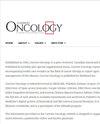Estrogen Regulated Genes Compel Apoptosis in Breast Cancer Cells, Whilst Stimulate Antitumor Activity in Peritumoral Immune Cells in a Janus-Faced Manner
IF 2.8
4区 医学
Q2 ONCOLOGY
引用次数: 0
Abstract
Background: Breast cancer incidence and mortality exhibit a rising trend globally among both premenopausal and postmenopausal women, suggesting that there are serious errors in our preventive and therapeutic measures. Purpose: Providing a series of valuable, but misunderstood inventions highlighting the role of increasing estrogen signaling in prevention and therapy of breast cancer instead of its inhibition. Results: 1. Breast cells and breast cancer cells with germline BRCA1/2 mutations similarly show defects in liganded estrogen receptor (ER) signaling, demonstrating its role in genomic instability and cancer initiation. 2. In breast tumors, the increased expression of special receptor family maybe an effort for self-directed improvement of genomic defects, while the weakness or loss of receptors indicates a defect requiring medical repair. 3. ER overexpression in breast cancer cells is capable of strengthening estrogen signaling and DNA repair, while in ER negative tumors, HER2 overexpression tries to upregulate unliganded ER activation and genome stabilization. 4. ER-positive breast cancers responsive to endocrine therapy may show a compensatory ER overexpression resulting in a transient tumor response. Breast cancers non-responsive to antiestrogen treatment exhibit HER2-overexpression for compensating the complete inhibition of hormonal ER activation. 5. In breast tumors, somatic mutations serve upregulation of ER activation via liganded or unliganded pathway helping genome stabilization and apoptotic death. 6. The mutual communication between breast cancer and its inflammatory environment is a wonderful partnership among cells fighting for genome stabilization and apoptotic death of tumor. 7. In breast cancers, there is no resistance to genotoxic or immune blocker therapies, but rather, the nonresponsive tumor cells exhaust all compensatory possibilities against therapeutic damages. Conclusions: Understanding the behavior and ambition of breast cancer cells may achieve a turn in therapy via applying supportive care instead of genotoxic measures.雌激素调控基因在抑制乳腺癌细胞凋亡的同时,以一种 "杰纳斯 "式的方式刺激瘤周免疫细胞的抗肿瘤活性
背景:全球绝经前和绝经后妇女的乳腺癌发病率和死亡率呈上升趋势,这表明我们的预防和治疗措施存在严重错误。目的:提供一系列有价值但被误解的发明,强调增加雌激素信号在预防和治疗乳腺癌中的作用,而不是抑制雌激素信号。结果: 1:1.乳腺细胞和具有种系 BRCA1/2 基因突变的乳腺癌细胞同样表现出配体雌激素受体(ER)信号转导的缺陷,证明了其在基因组不稳定性和癌症启动中的作用。2.在乳腺肿瘤中,特殊受体家族表达的增加可能是基因组缺陷的自我改善,而受体的减弱或缺失则表明缺陷需要医学修复。3.乳腺癌细胞中ER的过表达能够加强雌激素信号传导和DNA修复,而在ER阴性肿瘤中,HER2的过表达试图上调未加载ER的激活和基因组稳定。4.4. 对内分泌治疗有反应的ER阳性乳腺癌可能会出现代偿性ER过表达,导致短暂的肿瘤反应。对抗雌激素治疗无反应的乳腺癌会表现出 HER2 过度表达,以补偿激素对 ER 活化的完全抑制。5.5. 在乳腺肿瘤中,体细胞突变通过配体或非配体途径上调ER激活,有助于基因组稳定和凋亡。6.6. 乳腺癌与其炎症环境之间的相互交流是细胞为稳定基因组和肿瘤凋亡而斗争的一种奇妙的伙伴关系。7.7. 乳腺癌细胞对基因毒性或免疫阻断剂疗法不存在抗药性,相反,无抗药性的肿瘤细胞会用尽所有的代偿可能性来对抗治疗损害。结论了解乳腺癌细胞的行为和野心,可以通过应用支持性护理而不是基因毒性措施,实现治疗上的转机。
本文章由计算机程序翻译,如有差异,请以英文原文为准。
求助全文
约1分钟内获得全文
求助全文
来源期刊

Current oncology
ONCOLOGY-
CiteScore
3.30
自引率
7.70%
发文量
664
审稿时长
1 months
期刊介绍:
Current Oncology is a peer-reviewed, Canadian-based and internationally respected journal. Current Oncology represents a multidisciplinary medium encompassing health care workers in the field of cancer therapy in Canada to report upon and to review progress in the management of this disease.
We encourage submissions from all fields of cancer medicine, including radiation oncology, surgical oncology, medical oncology, pediatric oncology, pathology, and cancer rehabilitation and survivorship. Articles published in the journal typically contain information that is relevant directly to clinical oncology practice, and have clear potential for application to the current or future practice of cancer medicine.
 求助内容:
求助内容: 应助结果提醒方式:
应助结果提醒方式:


